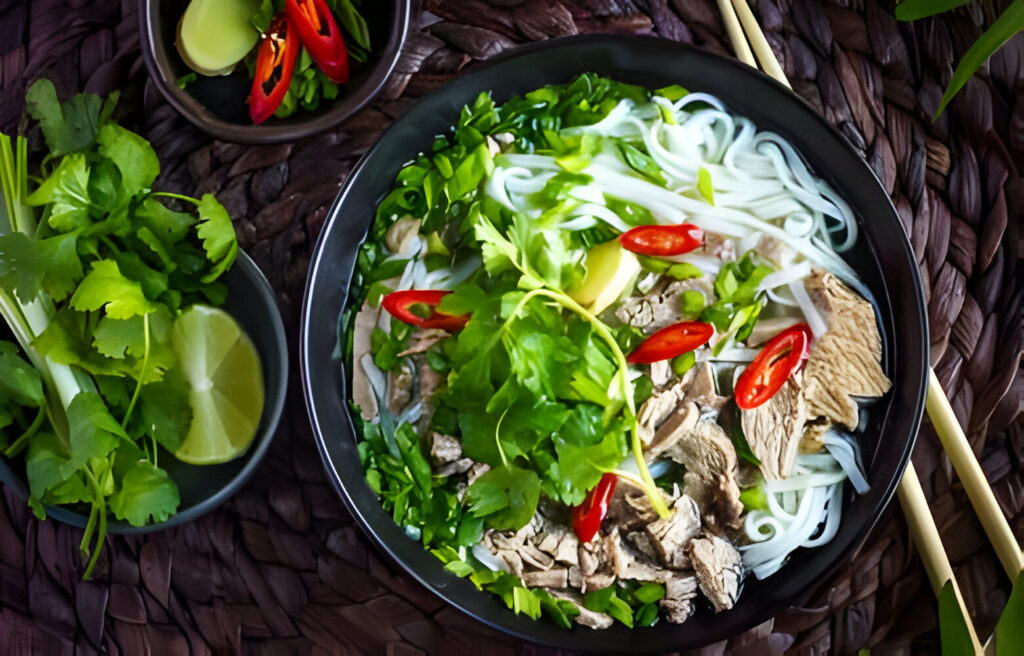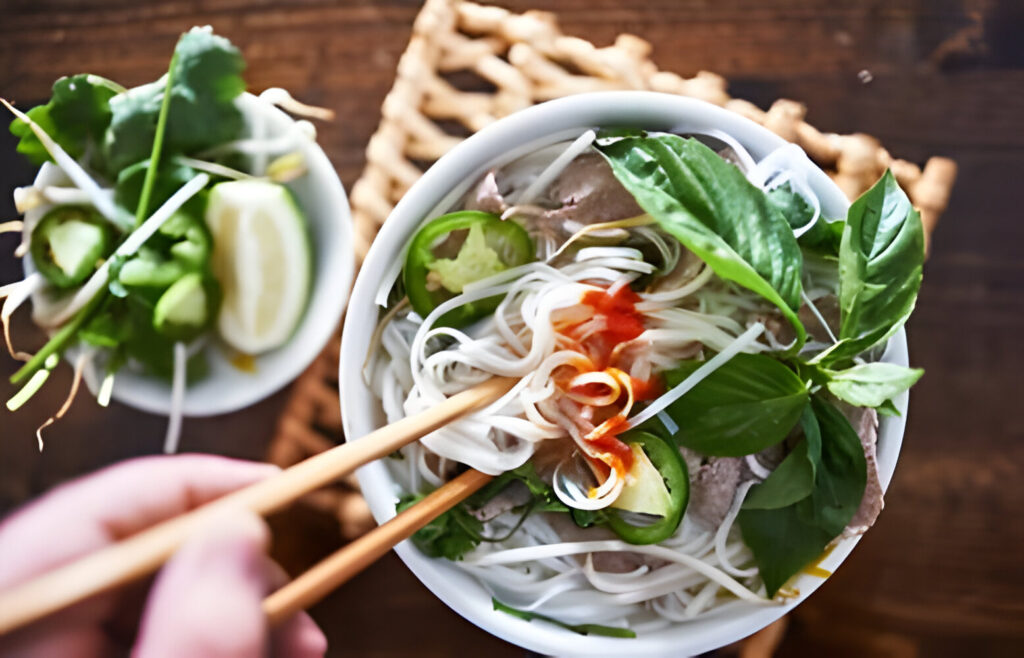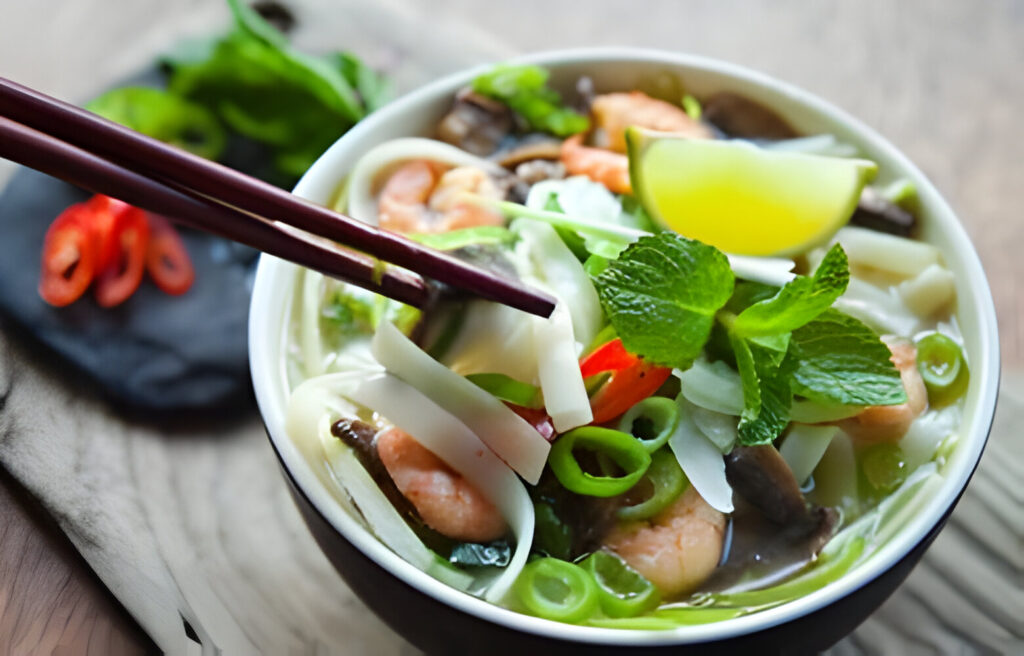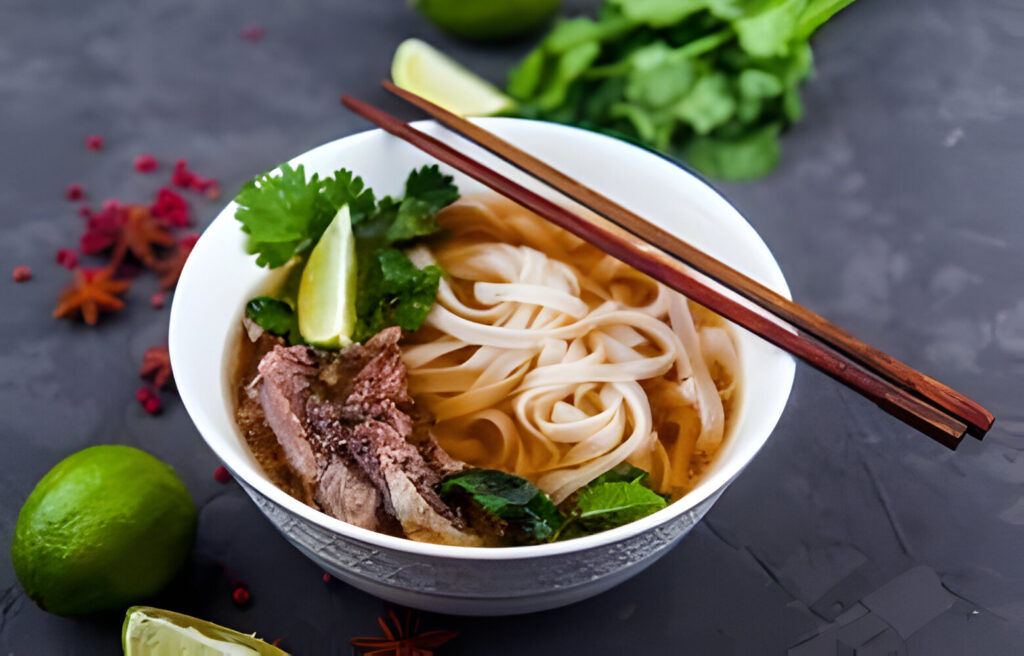
Introduction to sauces at pho restaurant and Its Cultural Significance
A Journey Through Time: The Origins of Pho
sauces at pho restaurant, a staple of Vietnamese cuisine, has captivated taste buds around the globe. Its inception dates back to the early 20th century in Northern Vietnam. Initially, it was a simple dish. Yet, it quickly became a national treasure. Today, pho represents the essence of Vietnamese culinary art on the international stage. Its rich history and cultural significance make it more than just a meal; it’s a culinary experience that connects people to the heart of Vietnam.
Global Acclaim: Pho’s Rise to Fame
From its humble beginnings, pho has journeyed far beyond Vietnam’s borders. Major cities worldwide now boast pho restaurants, each serving this delectable soup to an ever-growing fan base. Its global popularity stems from its unique flavors and the comforting warmth it offers with every bowl. This widespread acclaim highlights pho’s ability to transcend cultural barriers, making it a beloved dish worldwide.
The Role of Sauces in Pho: A Flavorful Customization
Sauces play a pivotal role in the pho experience. They allow diners to tailor the dish to their liking, adding depth and complexity to the broth. The most common sauces—hoisin, fish sauce, and chili—offer a balance of sweet, salty, and spicy flavors. By experimenting with these sauces, enthusiasts can customize their pho, making each bowl a personal culinary adventure. This aspect of pho not only enhances its flavors but also invites diners to engage with the dish on a more intimate level.
In summary, sauces at pho restaurant is more than just a traditional Vietnamese soup. It’s a culinary phenomenon that bridges cultures and invites customization through its sauces. Its rich history and global popularity underscore its significance in the culinary world, making it a dish cherished by food lovers everywhere. As we explore the essential sauces of pho cuisine, we delve deeper into what makes this dish truly extraordinary.
The Essential Sauces of Pho Cuisine
Exploring the diverse world of pho invariably leads to its soulful companions: the sauces. These not only add a layer of complexity but also allow personalization of the dish. Here, we delve into the quintessential sauces that define pho’s flavor profile, ensuring your pho experience is authentic and delightful.
Hoisin Sauce: A Sweet Depth
Hoisin sauce, a thick, fragrant sauce made from a combination of soy, garlic, vinegar, and various spices, brings a sweet and tangy flavor to pho. Moreover, its richness enhances the broth’s savory notes, creating a balanced taste experience. Diners often add a spoonful directly to their bowl, or dip their slices of meat into it, tailoring the sweetness to their liking. Consequently, hoisin sauce stands as a staple in the pho dining ritual, inviting you to explore the depths of its flavor.
Fish Sauce: The Umami Backbone
Fish sauce, the essence of Vietnamese cuisine, infuses pho with its unmistakable umami richness. Made from fermented fish, this clear, amber-hued liquid brings a profound depth to dishes. A few drops can transform the broth, elevating its flavor complexity. It’s this sauce that underscores the authenticity of pho, reminding us of its culinary heritage. Its salty profile harmonizes with the fresh herbs and spices, making it indispensable in achieving the signature taste of pho.
Sriracha or Chili Sauce: A Spicy Accent
For those who favor a fiery kick, Sriracha or chili sauce is the go-to. This sauce introduces a spicy heat that can be adjusted to suit individual preferences. Adding it to pho not only elevates the warmth but also introduces a vibrant color to the broth. It’s the choice for diners looking to customize their meal’s spice level, making every spoonful a personal statement. The sauce’s versatility ensures it caters to a wide array of taste buds, celebrating the diversity of pho enthusiasts.
Conclusion
The art of enjoying sauces at pho restaurant lies not just in its preparation but in how it’s personalized with sauces. Hoisin brings sweetness, fish sauce adds umami, and Sriracha offers heat. Together, they form the trifecta of flavors that make pho a beloved dish worldwide. By understanding and experimenting with these sauces, you can elevate your pho experience, making each bowl uniquely yours.

Regional Variations in Pho Sauces
Pho, Vietnam’s beloved noodle soup, varies not just in its ingredients but also in the sauces that accompany it. This diversity reflects the rich culinary tapestry of Vietnam. Here, we explore how regional differences influence the choice and use of sauces in pho, offering a glimpse into the country’s varied palate.
North vs. South: A Tale of Tastes
In the northern regions of Vietnam, pho retains a simplicity and purity in flavor. Here, the focus is on the quality of the broth and the freshness of the ingredients. Sauces, while present, play a more subdued role. Northern pho enthusiasts typically use fewer sauces, with a preference for fish sauce to enhance the broth’s natural flavors without overwhelming it.
Conversely, in the south, pho becomes a canvas for more vibrant and varied seasoning. Southern pho lovers embrace a broader array of sauces, including hoisin and chili sauce, to personalize their bowls. This region’s pho is characterized by a sweeter broth, complemented by the generous use of herbs and sauces. The result is a richer, more complex dish that invites diners to customize their experience with various sauce combinations.
Unique Regional Sauces
Beyond the well-known hoisin and fish sauces, local variations offer unique flavors. For instance, some regions might incorporate tamarind sauce for a tangy kick or a special homemade chili sauce that packs a punch. These local specialties add another layer of depth to the pho experience, showcasing the diversity within Vietnamese cuisine itself.
Embracing Local Flavors
Understanding these regional preferences not only enhances the dining experience but also offers insight into Vietnam’s culinary culture. It encourages diners to explore beyond the standard sauce offerings, delving into local traditions and flavors. This exploration can transform a simple bowl of pho into a journey through Vietnam’s culinary landscape, one spoonful at a time.
Conclusion
The regional variations in pho sauces illustrate the dynamic nature of Vietnamese cuisine, shaped by geography, climate, and cultural influences. From the minimalist approach in the north to the sauce-laden bowls in the south, each region tells its own story through the flavors it emphasizes. By exploring these differences, we gain a deeper appreciation for pho, not just as a dish but as a reflection of Vietnam’s rich culinary heritage.

DIY Pho Sauce Recipes for Home Cooks
Crafting your own pho sauces at home can elevate your culinary experience, bringing a touch of authenticity and personalization to your Vietnamese dishes. Here, we share recipes for making essential pho sauces from scratch, ensuring that even home cooks can achieve professional-level flavors.
Homemade Hoisin Sauce
Creating your own hoisin sauce involves a symphony of flavors, blending sweet, savory, and tangy elements. You’ll need:
- 4 tablespoons of soy sauce
- 2 tablespoons of peanut butter or a nut-free alternative
- 1 tablespoon of molasses or honey
- 2 teaspoons of white vinegar
- 1 garlic clove, minced
- 2 teaspoons of sesame oil
- 1 teaspoon of Chinese five spice
- A pinch of black pepper
Combine all ingredients in a bowl, whisking until smooth. If the mixture is too thick, add water by the teaspoon until you reach the desired consistency. This sauce not only complements pho but also works wonders as a dip or glaze.
Simple Fish Sauce Blend
Fish sauce is pivotal for its umami depth. For a balanced blend:
- 1 cup of water
- 1/2 cup of sugar
- 1/2 cup of fish sauce
- 1 garlic clove, finely chopped
- 1 or 2 red chilies, sliced (optional)
- Juice of 1 lime
Dissolve sugar in water, then stir in the fish sauce, garlic, chilies, and lime juice. Adjust chili to taste for heat. This versatile sauce can be stored in the refrigerator for up to a week, ready to add a splash of umami to your pho.
Spicy Sriracha Sauce
For those who favor heat, homemade Sriracha is a rewarding project. Ingredients include:
- 1 pound of red jalapeños, stemmed and halved
- 3 garlic cloves
- 3 tablespoons of light brown sugar
- 1 tablespoon of salt
- 1/2 cup of white vinegar
Blend the peppers, garlic, sugar, and salt until smooth. Ferment the mixture for 3 to 5 days, then simmer with vinegar before blending again. This fiery sauce adds a customizable kick to any bowl of pho.
Conclusion
By mastering these DIY sauces at pho restaurant sauce recipes, you not only add a personal touch to your dishes but also gain a deeper appreciation for the art of Vietnamese cooking. Experimenting with flavors allows you to tailor your pho to your taste preferences, making each bowl a unique culinary creation.

The Art of Sauce Pairing with Pho
Mastering the art of sauce pairing with sauces at pho restaurant can transform a simple bowl of noodle soup into a gourmet experience. Each sauce brings its unique flavor profile to the table, allowing for endless customization options. Here, we guide you through expert recommendations for sauce pairings based on different types of pho, enhancing both the taste and enjoyment of this beloved dish.
Beef Pho: A Balance of Bold and Savory
Beef pho, with its rich and hearty broth, pairs wonderfully with hoisin sauce and a splash of fish sauce. The hoisin sauce adds a sweet depth that complements the savory beef, while the fish sauce brings an umami kick that elevates the overall flavor. For those who enjoy a bit of heat, a small amount of chili sauce can introduce a spicy contrast that cuts through the richness of the broth.
Chicken Pho: Light and Fragrant Combinations
Chicken sauces at pho restaurant, known for its lighter and more delicate broth, benefits from subtler sauce additions. A squeeze of lime juice and a dash of fish sauce can enhance the broth’s natural flavors without overwhelming them. For a touch of sweetness, a thin drizzle of hoisin sauce can be used sparingly. This combination ensures that the chicken pho remains refreshing and balanced.
Vegetarian Pho: Enhancing Freshness with Tang
Vegetarian pho, abundant with fresh vegetables and tofu, pairs well with a brighter, tangier sauce profile. A homemade sauce combining lime juice, soy sauce, and a hint of chili provides a refreshing kick that complements the dish’s lighter components. The acidity of the lime and the saltiness of the soy sauce highlight the freshness of the vegetables, making each bite vibrant and flavorful.
Conclusion
Sauce pairing with pho is an art form that invites experimentation and personalization. Whether you prefer the robust flavors of beef pho, the delicacy of chicken pho, or the freshness of vegetarian pho, the right combination of sauces can elevate your dish to new heights. By understanding the flavor profiles of different sauces and how they complement various types of pho, you can tailor your meal to suit your taste preferences, ensuring a delightful and satisfying pho experience every time.
Elevating Your Pho Experience with the Right Sauces
The journey through the world of sauces at pho restaurant and its accompanying sauces comes to a delightful conclusion. Here, we encapsulate the essence of what makes pho a dish beyond mere sustenance, highlighting the integral role sauces play in elevating the pho dining experience to an art form.
The Symphony of Flavors
Pho, in its essence, is a harmonious blend of broth, noodles, meat, and herbs. Yet, it is the sauces that truly allow for a personalized touch, transforming each bowl into a reflection of individual taste preferences. The dance of sweet, salty, spicy, and umami flavors brought forth by hoisin, fish sauce, and chili sauce enriches the pho experience, making each bite a discovery of new flavors.
A Canvas for Creativity
The art of pho is not just in its preparation but in the final act of seasoning by the diner. This act invites creativity and experimentation, encouraging a hands-on approach to dining. It’s an invitation to play with flavors, to find the perfect balance that resonates with your palate. This process not only enhances the taste but also deepens the connection with the dish, making the experience uniquely personal.
Preserving Tradition, Embracing Individuality
While the sauces serve as a bridge between tradition and personal preference, they also represent the fluidity of pho as a culinary tradition. They allow us to honor the roots of this beloved dish while also making it our own. This balance between preservation and innovation is what keeps the culture of pho vibrant and alive, inviting both connoisseurs and novices to explore its depths.
Conclusion
As we conclude our exploration of pho and its sauces, it’s clear that the magic of this dish lies in its ability to bring together diverse flavors and traditions on a single plate. The right sauces not only enhance the taste but also elevate the entire dining experience, offering a journey through the rich landscape of Vietnamese cuisine. By embracing the variety of sauces and their uses, you can transform your pho into a culinary masterpiece, one that delights the senses and celebrates the rich tapestry of flavors that define this iconic dish.
More Articles From Maya’s Recipes: